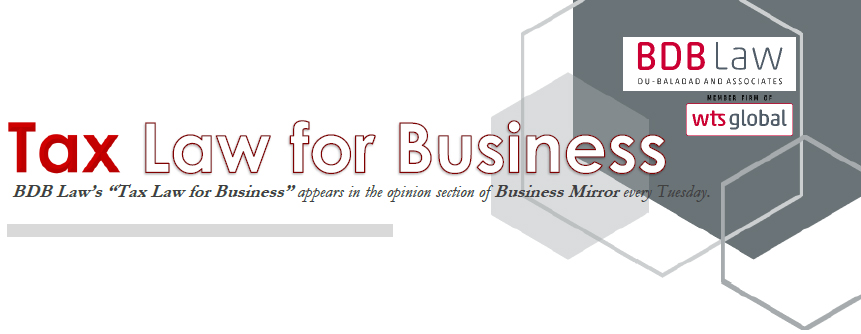
EOPT and the Promise of a Better Tax System
By: Atty. Jomel N. Manaig
"It should be noted that while the EOPT laid down the framework of a supposedly easier and more convenient future for taxpayers, the finer details of its application would have to be provided through the promulgation of its implementing rules and regulations (IRR) within 90 days from effectivity of the law. A lot may happen during that 90-day period. Hopefully, the IRR can still provide improvements to bring to life the progressive spirit of the EOPT."
 Atty. Jomel N. Manaig +632 8403-2001 loc. 140 |
The Ease of Paying Taxes (EOPT) has been in effect for the past couple of weeks and my colleagues have written extensively on it. From a general overview provided by Atty. Rodel Unciano to new specific features of the value-added tax as observed by Atty. Fulvio Dawilan, and all the way to the precise changes in the creditable withholding tax refund as remarked by Atty. Mabel Buted. Despite these extensive write-ups, there is still a lot to unpack in the EOPT.
It should be noted that while the EOPT laid down the framework of a supposedly easier and more convenient future for taxpayers, the finer details of its application would have to be provided through the promulgation of its implementing rules and regulations (IRR) within 90 days from effectivity of the law. A lot may happen during that 90-day period. Hopefully, the IRR can still provide improvements to bring to life the progressive spirit of the EOPT.
 On the classification of taxpayers into micro, small, medium, and large taxpayers, the EOPT already provided for certain concessions for the first 2 classifications to make tax administration easier. However, I would argue that a lot can still be done. Micro and small taxpayers make a significant portion of the business enterprises in the Philippines but their size makes it difficult to comply with the current tax administration requirements.
On the classification of taxpayers into micro, small, medium, and large taxpayers, the EOPT already provided for certain concessions for the first 2 classifications to make tax administration easier. However, I would argue that a lot can still be done. Micro and small taxpayers make a significant portion of the business enterprises in the Philippines but their size makes it difficult to comply with the current tax administration requirements.
While a simplified tax system would do wonders for micro and small taxpayers, it may require legislation which only Congress may do. Nonetheless, the IRR may still make tax compliance easier for micro and small taxpayers by providing rules to make bookkeeping simple and less complicated. Tax reporting may also be reduced to annual reports only and remove reporting on a monthly/quarterly basis.
For medium taxpayers, care should be exercised in crafting the rules on tax compliance because of the extremely wide threshold of gross sales provided under the EOPT. While medium taxpayers may have a better ability to comply with stricter tax obligations, the wide threshold may encompass taxpayers that are so far apart in terms of compliance capabilities that uniform rules may prove to be inadequate, if not unfair.
On record-keeping requirements, the EOPT provided for a definite 5-year period within which taxpayers are required to preserve books and other records. This should, however, be harmonized with the 10-year prescriptive period to assess in cases of fraud. What would the rules be in case a taxpayer disposes of its records after the 5-year period but is subsequently examined under allegations of fraud?
Further, considering that the EOPT includes provisions on the digitalization of the BIR services and the strengthening of the BIR’s technology capabilities, rules should be set up to avoid or minimize requesting from taxpayers documents/records/returns that is already part of the taxpayer’s periodic reportorial requirements.
On the refund of excess, unused, and creditable input tax, the classification of refund claims to low-, medium-, and high-risk claims is a welcome respite. By introducing these classifications, the BIR may now focus its audit/verification process on medium- and high-risk claims. Nonetheless, what would be the basis for classifying a claim into any of the 3 classifications? Will a low-risk classified claim actually lead to an approval within the prescribed period to process the application?
It should be noted that the return of the “deemed denied” provision should not operate to dilute the purpose of having claim classification. Failure to timely act on an application, especially if considered as low-risk, is the anathema of an effective refund system.
Lastly, on the refund of excessively or illegally collected taxes, the introduction of definite periods to process a refund claim is truly a great relief for taxpayers. Having a definite 180-day period from the submission of complete supporting documents should give taxpayers a greater appreciation on the processing of their respective claims.
However, it now means that the BIR will provide for lists of “complete supporting documents” catered to specific taxes being refunded. In crafting these lists, the BIR should not go overboard and prescribe a daunting list of documents. Doing so is not consistent with the message of “ease to the taxpayers” that the EOPT is espousing. In addition, the BIR should likewise consider jurisprudence in making the list since not all tax refunds should be met with strictissimi juris (strictly construed against taxpayers). In case a more lenient standard is appropriate, the documentation required should likewise reflect it.
These are just a few matters I hope that the powers that be would consider in crafting the IRR. In due time, we will see if the IRR will live up to the promise of the EOPT.
The author is a junior partner of Du-Baladad and Associates Law Offices (BDB Law), a member-firm of WTS Global.
The article is for general information only and is not intended, nor should be construed as a substitute for tax, legal or financial advice on any specific matter. Applicability of this article to any actual or particular tax or legal issue should be supported therefore by a professional study or advice. If you have any comments or questions concerning the article, you may e-mail the author at This email address is being protected from spambots. You need JavaScript enabled to view it. or call 8403-2001 local 380.



